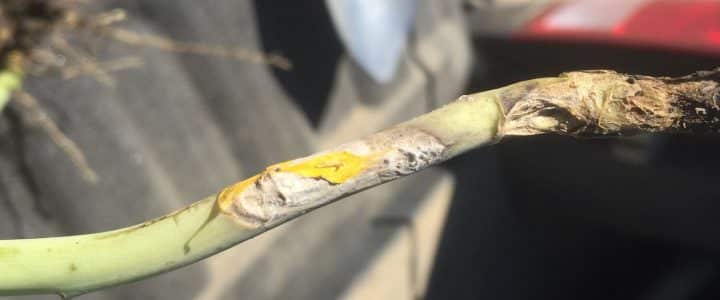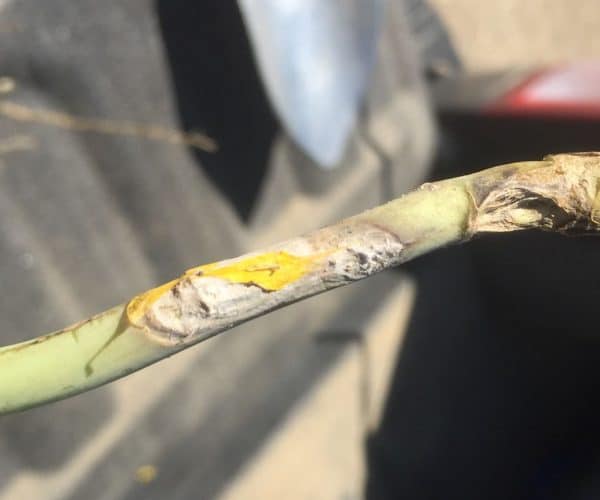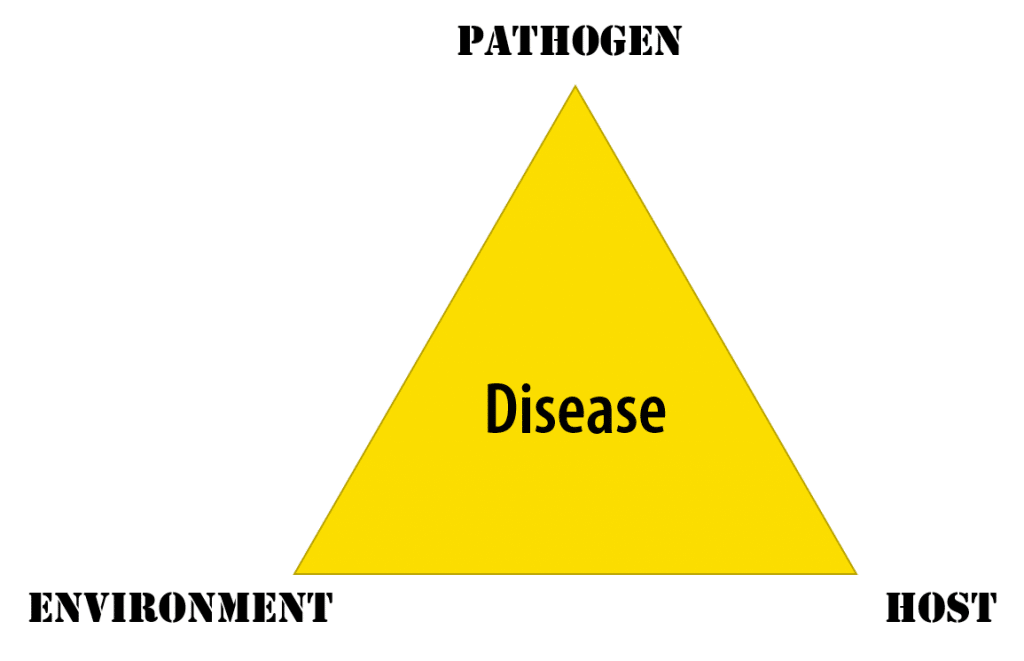Sclerotinia disease cycle overview
Sclerotinia stem rot is a plant disease that can occur in canola when conditions are favourable. As with all diseases, this happens when an appropriate host plant is present, environmental conditions are conducive and the pathogen is present (known as the disease triangle). In the case of sclerotinia stem rot, the pathogen is the fungus Sclerotinia sclerotiorum. It overwinters in the soil as sclerotia and germinates to form apothecia when conditions are suitable. The apothecia release ascospores into the air, which can subsequently infect host plants, such as canola, that it lands on. The resulting symptoms can include wilted leaves, lesions and premature ripening. New sclerotia – which look like small black cylinders- will form inside the stem. When the leached, brittle stems break open in the fall, the sclerotia will fall back to the soil to overwinter again. Read more about this disease cycle in the Canola Encyclopedia.
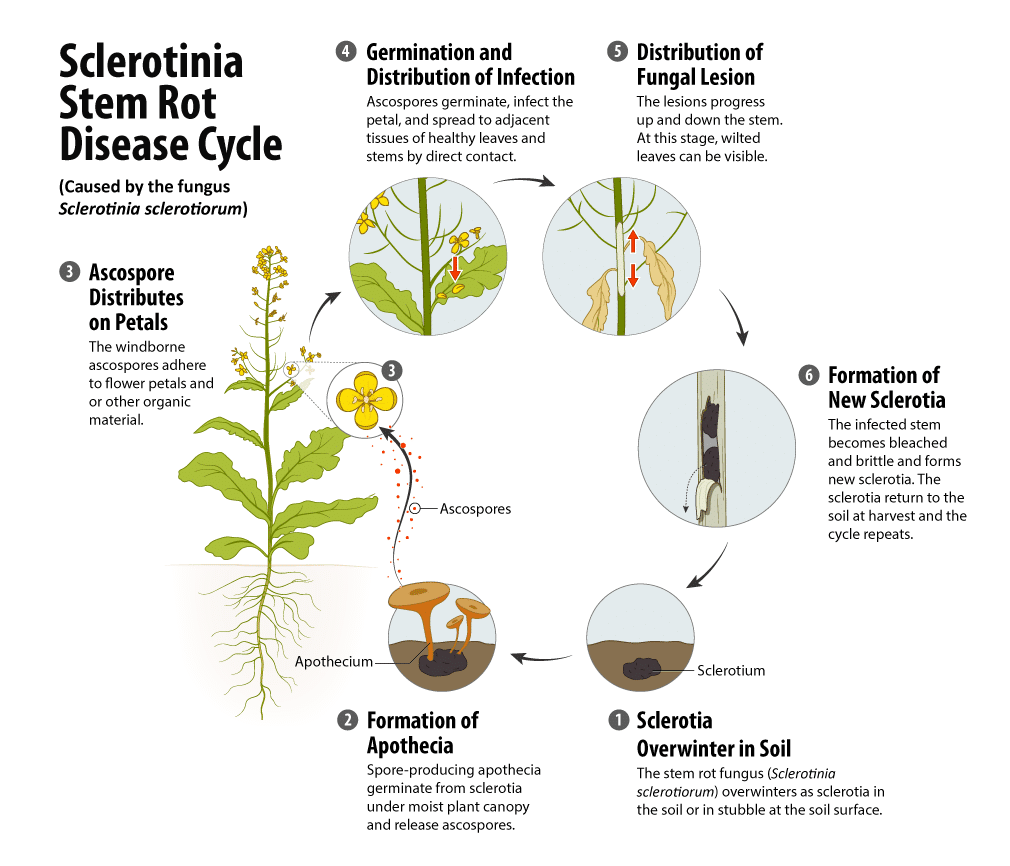
Impact of sclerotinia stem rot on canola growers
This disease can have a significant impact on seed yield and therefore affect a growers’ economic return on producing a canola crop. Since it is also widely distributed across Manitoba, Saskatchewan and Alberta at varying levels of incidence and severity, it is significant to a high percentage of canola growers. For this reason, improved understanding of both the pathogen and the conducive environmental conditions which allow this disease to impact canola is needed to better manage the crop with minimal economic loss.
Sclerotinia stem rot risk assessment and prediction models
The major in-season management decision growers need to make is whether to apply a fungicide or not (which can be assisted by reviewing a sclerotinia risk assessment checklist). Once this is decided, timing of the application is crucial (between 20 and 50 per cent bloom, with optimum timing typically around 30 per cent bloom) to maximize its impact. However, to make better risk assessments of whether a spray application is warranted or not, improved prediction models are needed. Despite significant research, these models have been difficult to create, due to a lack of strong relationships between environmental conditions and resulting disease impact. Some projects which have tried to address this challenge from various approaches include:
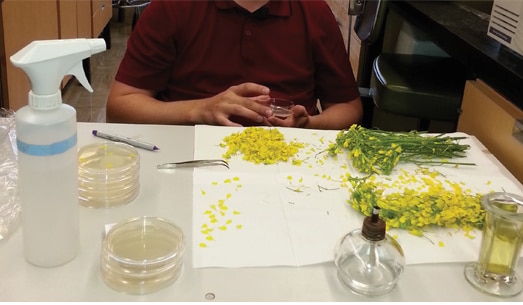
- Turkington’s ‘Facilitating the delivery of practical sclerotinia stem rot risk forecasts based on improved assessment of canola petal infestation’ research developed a method to detect the presence and amount of S. sclerotiorum DNA on canola petals collected in the field (with minimal false negatives) and the relationship the presence and amount had with resulting disease incidence, to test it as a risk assessment (prediction) tool.
- With a focus on the microclimate within the plant canopy, the ‘Weather-based assessment of sclerotinia stem rot risk’ project led by Bullock did not find a correlation between average daily temperature or relative humidity values and daily ascospore levels. The study also showed very similar canopy air temperatures in the high, medium and low density plots, with the low density plots reporting significantly lower relative humidity. The impact of moisture couldn’t be determined in this study, but field history was a factor in overall disease incidence (however it did not affect ascospore release timing).
- Li’s proof of concept research used an inventive technique of using electrical conductivity (of the nanoparticle-ascospore complexes) to estimate the number of ascospores present. Results showed that conductivity measurement was able to detect as low as five ascospores of Sclerotinia sclerotiorum in the sample, which could be utilized in the development of an in-field sensor for the detection of plant disease pathogen levels.
- Strelkov’s ‘Development of a rapid quantitative detection method for sclerotinia stem rot inoculum to aid disease risk assessments and fungicide spray decisions’ research led to the development of the first Canadian method for detection and measurement of S. sclerotiorum levels. However, the relationship between (disease-causing) inoculum levels and disease incidence was determined to be as complex as factors such as weather, crop density, and seeding date influenced the disease pressure.

- Burlakoti’s research team was able to create and verify a sclerotinia risk model and sclerotinia score card using sclerotinia biology and disease cycle information as well as previously developed sclerotinia checklists for the Prairie provinces. The score card has both weather and agronomic variables as input variables (including cumulative rainfall, average maximum temperature two weeks before canola crop stage BBCH 65, average daily wet hours, cumulative rainfall, days of rainfall, average maximum temperature five days before to three days after canola crop stage BBCH 65, number of years canola or host crop was present, disease incidence in last year’s crop, plant density, and varietal resistance). Additional details are provided on the Operational models to forecast canola growth stage, sclerotinia risk, and yield in Western Canada project page.
Cross-commodity management considerations for sclerotinia
Since the fungus Sclerotinia sclerotiorum can impact all broad leaf plant species, and Canadian farmers grower many different crops on the Prairies, Harding’s ‘Improving sclerotinia disease control in edible beans and canola’ considered management for two commodities. The project examined whether there is a benefit from a micronutrient and a sclerotinia fungicide combination on bean white mould and sclerotinia stem rot management for canola. Fluazinam activity was the most responsive to the micronutrient tank-mix in reducing S. sclerotiorum biofilm. However, while the effects of tank-mixing of some micronutrients with fungicides were easily measurable, and statistically significant in laboratory testing, their efficacies in the field were often not discernible due to low disease pressure and other variables that could be controlled in the field. As a result, any consistent beneficial effect due to tank-mixing fungicides with micronutrients could not be confirmed in the field trials.
Genetic resistance approach to managing sclerotinia stem rot
Canola breeding is also being used to develop genetic resistance to sclerotinia stem rot disease. This includes many interesting discoveries and developments, such as:
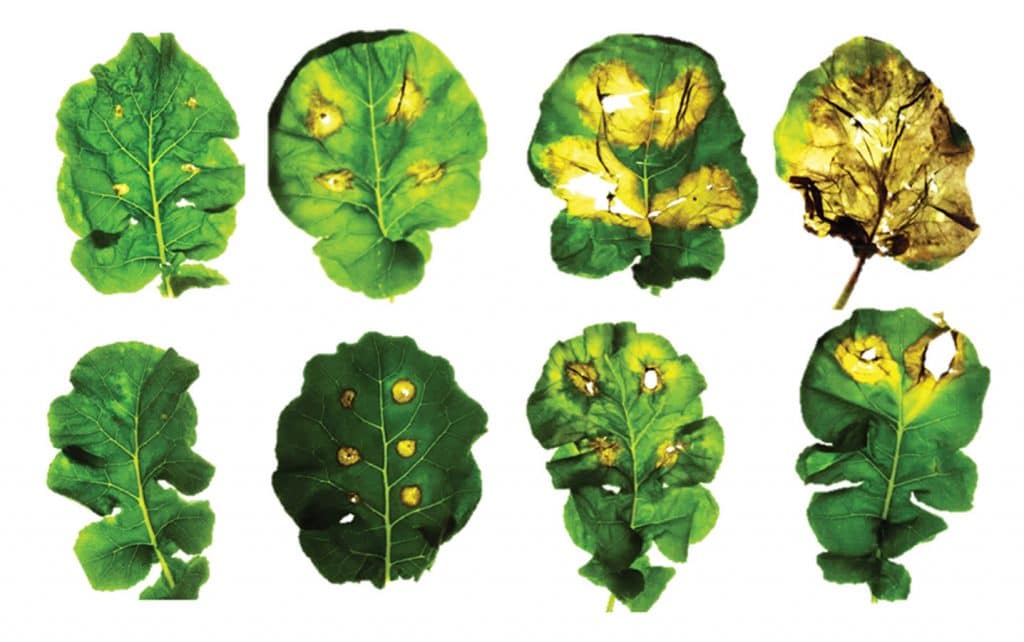
Westar (susceptible) samples are on top and ZY821 (tolerant) samples are on the bottom. Rows of samples depict 24, 48, 72 and 96 hours post inoculation (left to right).
- An impressive advance for sclerotinia resistance screening in the ‘Development of Sclerotinia Resistant Brassica Napus Lines and Molecular Markers for Marker-Assisted Breeding’ study. This allowed Agriculture and Agri-Food Canada researchers to identify new sclerotinia-resistant germplasm, develop molecular markers and identify additional B. napus defense genes, which will help researchers generate the breeding tools needed to development sclerotinia-resistant cultivars.
- Once sclerotinia stem rot-tolerant varieties were made available, Fernando’s ‘Getting one step closer to sclerotinia control through cultivar resistance and biological applications’ research improved on varietal resistance. The researchers identified previously undiscovered genes associated with the plant defense response, providing valuable resources for researchers interested in developing sclerotinia-resistant canola lines.
- More recently, Buchwaldt’s research generated new knowledge on individual defense genes against S. sclerotiorum and on SNP and SSR markers that can be used in marker-assisted selection (in the breeding process). A sclerotinia stem test to screen B. napus plants for sclerotinia resistance was also developed and accepted by the canola industry through the Characterization of defense genes underlying quantitative resistance loci (QRL) to sclerotinia stem rot in Asian Brassica napus and transfer of resistance to Canadian spring-type canola study.
- Also, Hegedus’ research contributed to an international consortium that sequenced the S. sclerotiorum genome, which is now serving as a reference for a new international initiative to sequence the genomes a global collection of S. sclerotiorum isolates from a multitude of crops. The ‘Resistance to Sclerotinia sclerotiorum necrosis inducing proteins in canola’ research, focused on how S. sclerotiorum causes the most noticeable and damaging aspect of disease in canola, namely, the necrotic lesions on the stem that lead to lodging and crop loss.
Ongoing sclerotinia stem rot research
Researchers continue to build on findings from all of these previous studies. They further investigate aspects of this disease in these projects, which are currently in progress:
- Development of a biosensor for Sclerotinia stem rot disease forecasting in canola
- Resistance to Sclerotinia sclerotiorum effectors in canola
- Improving the management of sclerotinia stem rot of canola using fungicides and better risk assessment tools
- Biopesticides as a novel management strategy for sclerotinia in canola
- Pre-breeding lines combining canola quality with sclerotinia resistance, good agronomy and genomic diversity from PAK93
More sclerotinia studies, or research on other canola diseases are available on the Canola Research Hub.
Published July 9, 2021


